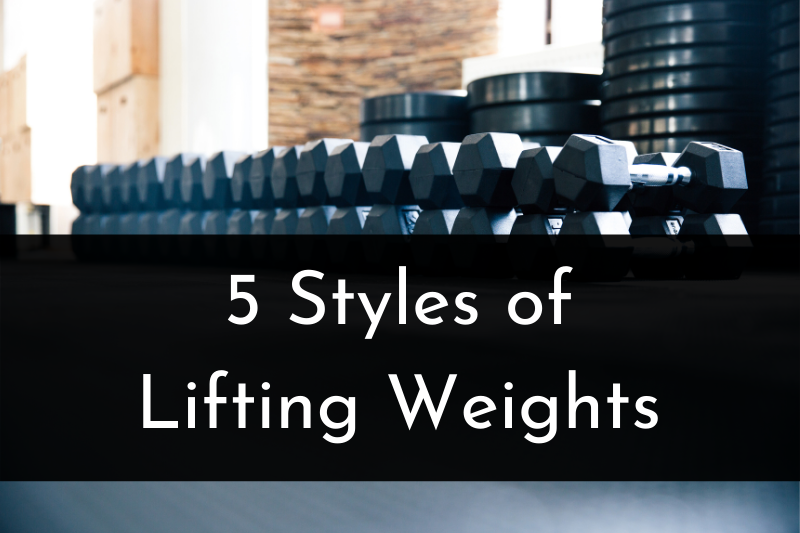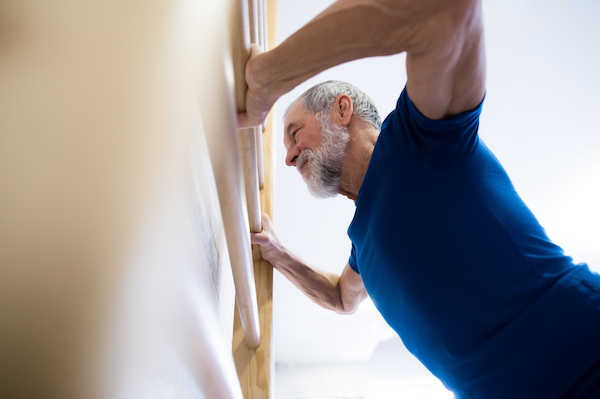
There are a few different types of strength training you’ve probably heard of:
- Powerlifting
- Bodybuilding
- Olympic weightlifting
- CrossFit
- And more
But chances are, unless you’re looking to compete at least semi-professionally in one of these areas, you’ll be best served by including a mixture of all of them in your training.
The different styles of weight lifting and strength training come down to personality and goals.
The main styles of weight lifting are:
- Training to look good
- Training to compete
- Training for overall health & athleticism
- Training for seniors & injury rehab
- Training for fun & fitness
Let’s take a look at each of these goals, how to choose which one is right for you, and some tips for each weightlifting style — with the help of some personal trainers and world champion lifters.
Let’s go!
Training to look your best
Lifting weights is truly one of the best ways to transform your body and look your best.
Working with different types of free weights (dumbbells, barbells, kettlebells, etc.) is obviously a great way to build muscle, but strength workouts are also exceptional for fat loss.
(You’ll have to eat right to lose weight, of course, but proper strength training can help you preserve or even build muscle while losing fat, resulting in incredible transformations.)
Fat loss + muscle gain = Looking absolutely amazing!
How to train if you want to look your best
For aesthetic purposes, you’ll want to get and keep your bodyfat percentage fairly low.
(The threshold for visible abs is somewhere around 10% for men and 19% for women.)
That means dialing in your diet. Primarily, you’ll need to:
- Eat in a consistent caloric deficit
- Eat enough protein
When it comes to your training, it’s time to separate fact from fiction.
High-rep “toning” workouts don’t actually tone your muscles or burn way more calories for weight loss. They build muscular endurance, which is a good thing, but they aren’t a magic solution to looking ripped.
Incorporate lots of lower rep work and big, compound lifts (squats, bench press) to preserve strength and muscle as you lose weight.
Just don’t forget…
There’s nothing wrong with training primarily to look good and feel confident in your body, just don’t forget about your overall health and fitness while working on those biceps.
Incorporating full body training and compound lifts is a really good start to keeping your whole body strong and healthy, not just your glamour muscles.
But you might want to incorporate some basic cardio, conditioning, or GPP (general physical preparedness) to have a more well-rounded fitness profile and not just pretty muscles.
Training to compete (Powerlifting, bodybuilding, CrossFit, other)
If you’re ambitious, or really strong, there are a lot of great ways to put your strength to the test.
You can compete in contests like:
- Bodybuilding
- Men’s physique
- Powerlfiting
- Strongman
- CrossFit
- Olympic weight lifting
- And more
You don’t have to go pro or commit the rest of your life to these disciplines.
A lot of amateurs who are serious about their training sign up for the occasional contest for an extra challenge when it suits them.
How to train if you want to compete
If you’re serious about competing at a pro or semi-pro level, you’ll want to get a coach that has specific expertise in your competition area.
The trainers at 24 Hour Fitness probably won’t be able to get you ready for a big powerlifting meet, for example!
But if you’re just starting out, you can almost always find a free or cheap workout program online for your discipline.
Wendler’s 5/3/1 and StrongLifts 5×5 are both solid foundations for either powerlifting, strongman, or bodybuilding — for example.
Build a base of muscle and strength and then specialize when you’re ready.
Just don’t forget…
Don’t forget to take your time, learn proper form, and build a strong foundation.
World champion powerlifter Robert Herbst says:
“For the aspiring powerlifter, I would tell them to learn proper form and technique, don’t rush things but allow your tendons to gain strength, and listen to the older and more experienced lifters who have paid their dues.”
He also adds that you should keep your ego in check as you advance in your sport.
“Also, as they get stronger, don’t be a dick. The strongest men in the world are humble and wear long sleeves. They can be that way because they know the power is there.”
Training for overall health & athleticism
A lot of people gravitate toward dumbbells and barbells at the gym not to have huge muscles, a six pack, or to win a powerlifting trophy — but simply because they know strength training is an important piece of staying fit overall.
In fact, they may incorporate a little bit of weightlifting or strength training to improve their performance in other areas, like tennis, swimming, or running.
It turns out that the benefits of weight training are vast.
It can improve bone density, manage chronic pain or other conditions, and even improve your critical thinking skills according to Mayo Clinic.
So if you’re not interested in big muscles or rippling abs, you should still consider picking up a dumbbell every now and then!
How to train for overall health & athleticism
For the best results as a non-dedicated lifter, your primary concern should be avoiding injury and overuse.
You’ll likely want to avoid lifting exceptionally heavy weights in the super low-rep zones (like 1-3).
Low reps are great for strength, but can be dangerous if you don’t put in the time to learn how to handle them.
For regular folks, Mayo Clinic suggests staying in the 12-15 rep range for a balance of muscle growth and endurance.
Just don’t forget…
Don’t forget to take frequent rest days to avoid injury and overuse.
If you’re not completely hammering your muscles into the ground and making yourself sore, it might be tempting to lift super frequently.
But without proper recovery, your muscles won’t grow or strengthen over time.
The American College of Sports Medicine recommends at least 48 hours of rest after a workout before challenging that same muscle group again.
And Herbst says you should be careful that lifting weights is improving your performance in other areas, not taking away from it:
“I would say pick your exercises wisely to not get tendinitis and other overuse injuries and remember that your body is a total system with a finite amount of energy and resources. They should balance their training so that too much of one does not take away form the other, which can lead to declining performance and even injury.”
Training for older folks & injury rehab

Weight lifting is great for pushing your body to the limit and transforming your body composition.
But it’s also great at keeping you strong as you age or helping you bounce back from an injury.
Just… as long as it’s done properly.
For example, most knee pain or injury rehab involves strength movements — granted, done with little to no resistance at first — rather than cardio. Strengthening the muscles and ligaments in the affected area is the quickest path toward feeling better.
And for seniors and older adults, the muscle and bone health benefits of strength training can keep you feeling younger for far longer than higher-impact workout options. Silver Sneakers highly recommends all seniors give it a try!
How to train for aging or injury rehab
If you have an injury or any kind of chronic pain, don’t self diagnose and treat in the gym.
You’ll want the help of a doctor or physical therapist, or at least a personal trainer who can steer you in the right direction.
Strength training is amazing at correcting muscle imbalances and alleviating pain, but it can just as easily make things worse if you train improperly.
For seniors, have fun with your strength workouts but don’t push too hard.
Herbst says “Be sure to lift with proper form, keep things in the high rep range to prevent injury, and support yourself with proper nutrition and sleep.”
Start with a strength program designed for folks in your age group rather than diving into a bodybuilding or powerlifting program.
Training for fun and fitness
I personally fell in love with lifting weights after trying nearly every other form of exercise.
Nothing else stuck because I found other workouts boring, grueling, or tedious.
Lifting weights can and should be fun, especially if you’re not locked into training for a competition or maximum muscle growth.
Even casually lifting weights can work wonders for your muscles and bones over time, so it’s a good idea for almost everyone to incorporate some strength training here and there!
How to train for fun and overall fitness
Mix things up frequently.
If you’re not training for a specific strength goal, like boosting your bench or squat, you should enjoy incorporating a lot of variety into your routine.
Build up a base of strength with the classic lifts, but have fun with some funky movements and unique exercises.
Try training like a CrossFitter for a while. Then try bodybuilding workouts. Build up strength like a powerlifter. Master calisthenics. Then test your endurance with interval and complex workouts.
Do whatever feels good and interests you and don’t ever feel locked in by what experts say you “should” be doing.
Just don’t forget…
“Program hopping,” or changing up your routine frequently, is great for keeping things fresh.
But remember to adhere to the golden rule of all exercise: progressive overload.
If you’re not making any measurable progress on a specific lift or exercise, you won’t get results.
Without a new challenge (more weight, more reps, less rest) your body will stop adapting. Your muscles won’t grow. Your workouts will be fun and burn calories, but they’ll ultimately be ineffective.
Stick to your chosen lifts for at least a couple of workout sessions, or long enough to add a few reps.
Keep track of your PRs (personal records) over time so you know if you’re any stronger or fitter than you were a year ago.
Wrapping Up
See? Lifting weights isn’t just for meatheads or bodybuilders.
You can lift for:
- Fun
- Looks
- Competition
- Overall fitness
- Healthy aging
- And injury rehab
You can even choose a mixture of all of the above!
Just never forget the fundamentals of progressive overload and proper form, however you choose to train. And be sure to get help from a professional if and when you need it.
Before you go, check out more on lifting weights like:
And if it looks like strength training isn’t for you, you might find a better fit with the different styles of yoga.
Hope this helps!